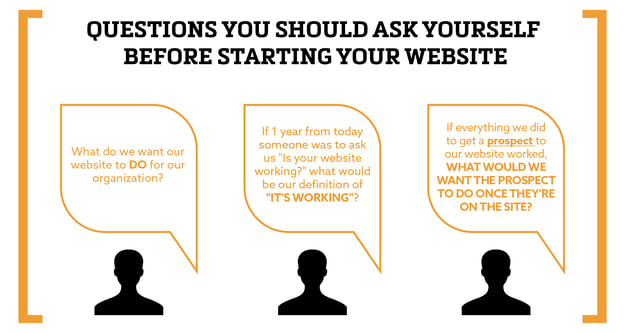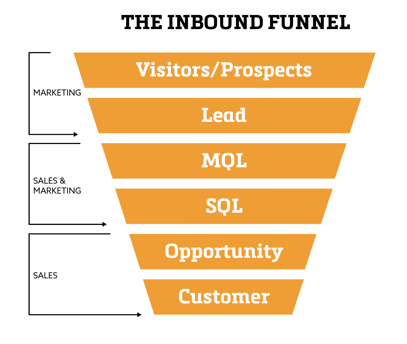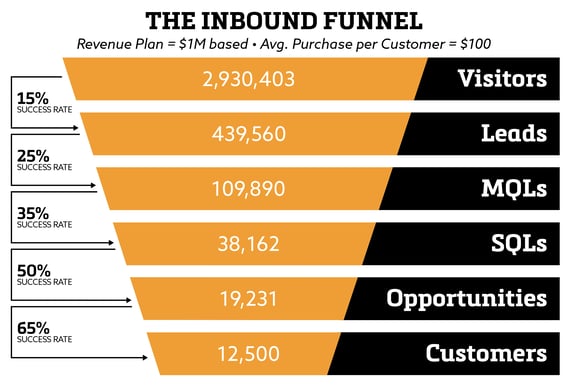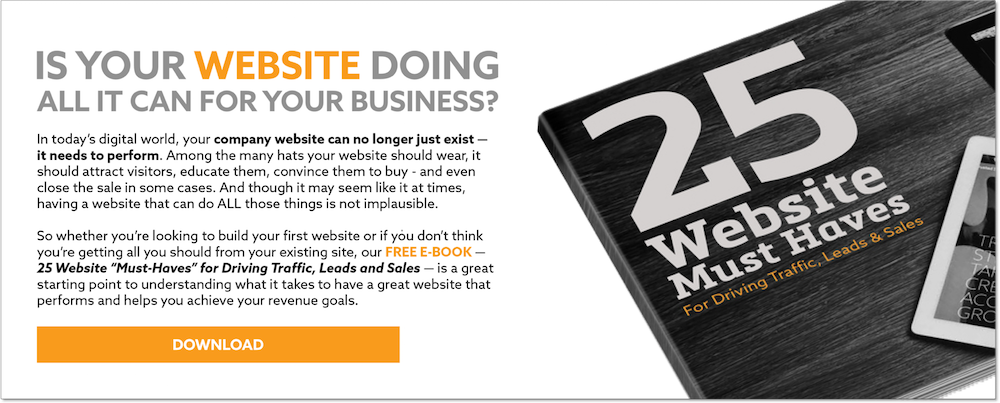
It happens in just about every organization. It usually happens when it's time to update the Marketing Dashboard, when someone (anyone) wants to do something (anything) to the company website or when someone is trying to make some sort of "data-driven" point. It typically comes from someone higher up in the organization—maybe a VP or even the President. And it's usually phrased in the form of a question. Take a few minutes to see if you can determine what "it" is.
"What are the analytics on our website?" (or the alternative, "Can we get some analytics on our website?")
I always loved that question (roll eyes).
Those of us who have been responsible for answering that question are used to it, and most of us have developed a similar canned response (also in the form of a question): "What kind of analytics would you like?"
And most of the time, we already knew the answer to that silly question, "Just, you know, some basic analytics."
Basic analytics? BASIC ANALYTICS!?!? What does that even mean?
Any site that has installed Google Analytics has gobs (literally, GOBS) of data and analytics that can be sliced and diced in a million different ways — visitors and bounce rates and average time spent on the site and on each page and those can be cross-referenced with demographic and geographic data with varying degrees of granularity... and so much more.
But the request is typically for "basic analytics". And usually, the primary "basic analytic" that is requested is what kind of traffic the site is getting. It's as if by knowing how much traffic the site is getting, one could determine the success (or lack thereof) of the website.
Well, actually, we think there is — but it may not be in a way that you think. It's all based on what you want your website to do for your business. Keep reading... you'll see what we mean.
What do you want your website to "DO"?
We all know just how important a website is not only to the online strategy of any organization, but to the overall marketing strategy as well. In today's world, it's nearly impossible to conceive of a business —whether B2B, B2C, non-profit, local, or global — that doesn't need an online presence to reach customers. A company’s website has become not only its virtual storefront but also its primary face to the market. But simply having a website isn’t the key to great "results". It's not enough for a website to just exist; it needs to perform. It needs to attract visitors, educate them, convince them to buy, and even close the sale in some cases. So the first thing an organization needs to ask themselves about their website is:
- What do we want the website to DO for our organization?

If you can answer that question, you're not only on your way to having a GREAT website, but also to being able to determine how much traffic your website should have.
How?
Well, if you DON'T really know what you want your website to DO for your organization, it becomes very difficult to make decisions about how the website should look or how it should work. It also becomes difficult to know what type of content your website should have and what you should do to effectively market the website.
Think about it... if you DON'T really know what you want to get out of your website, what context or frame of reference do any analytics actually have? How would you know if 1,000 visitors/day or 10,000 visitors/day was good or bad (or what it even meant)? How would you know if visitors spending less/more time on specific pages was because they found what they were looking for or because they couldn't find what they were looking for?
You may think that you could measure your website analytics against some industry benchmark or your competitors. But getting industry and/or competitor information on website traffic is not very easy to do. Even if you could, what would that data actually mean to your organization? For example, if your competition was achieving their goal of selling 1,000 widgets per month with 5,000 visitors/month traffic, what would your website's 20,000 visitors/month even mean?
Now, if you know what you want your website to DO, understanding how much traffic your website should have is really just about the math...
It's All About the Math
Let's say that the Sales Process Map for your organization contains some version of a Sales Team following up on leads and closing them for sales. So, let's say that the goal of your website is to provide quality leads for your sales team. Here's one (rather simple) example of how you could determine how much traffic your website should get:
- THE FUNNEL:

We've all seen a marketing and sales funnel where prospects go into the top of the funnel and some percentage of those prospects come out as customers at the bottom of the funnel. While many of today's more successful organizations have much more alignment and interrelation between Sales & Marketing, generally speaking, Marketing owns the top of the funnel and Sales owns the bottom of the funnel. There's generally a place in the middle where ownership of leads is transferred from Marketing to Sales. This place can be a really cumbersome and "clunky", but it's also a critical piece in determining whether the funnel actually yields the appropriate results. So, how does this help you determine how many visitors your website should be getting? Well, it's all about working the funnel from the bottom up.
For the purposes of our example, let's assume that we have an organizational goal of generating $1M in revenue from our website activity, and from historical data, we've seen that each customer is worth approximately $100 in revenue. Again, this is a simplified example for the purposes of helping to understand how you CAN develop a model of how much traffic your website should be getting. If we were developing the model for actual use, we'd probably want to look at the Customer Lifetime Value (CLV) instead of the revenue number, but explaining the CLV is a little more complicated, and we didn't want to confuse this post.
So, let's build our funnel:
- CUSTOMERS: In order to determine how many visitors we should have to our website, the first thing we need to determine is how many customers we want to have at the bottom of the funnel. We know we want achieve the $1M revenue, so we'll set a "stretch" goal that is MORE than $1M. We set the stretch goal for two reasons: 1) we know nothing ever goes as planned, and 2) stretching for more than our target gives us the outside chance that we may actually surpass our $1M objective. So, with that data we have, we can then calculate how many customers we will need to achive our stretch goal of $1.25M:
- $1.25M Revenue ÷ $100 Revenue/Customer = 12,500 Customers
- THE OPPORTUNITIES: Opportunities are generally defined as a Sales Qualified Leads (SQLs) with whom a sales rep has communicated and identified as a legitimate potential customer.
We all know that no organization bats 1,000 when it comes to closing sales. Based on your historical data, you should be able to determine how many of your organization's Opportunities actually become Customers. For the purposes of this example, we'll assume that once a prospect has been identified as an "Opportunity", he or she ends up becoming a customer 65% of the time. Therefore, as we develop our model, we know that in order to achieve $1.25M in Sales, we'll need to identify 19,231 Opportunities because only 65% of them will become customers:- 12,500 Customers ÷ 65% Success Rate = 19,231 Opportunities
- LEADS, MARKETING QUALIFIED LEADS (MQLs), and SALES QUALIFIED LEADS (SQLs): As we further develop our model, we come across a few terms that need a little definition. Leads are contacts who have submitted a form on your website in return for a content offer like an E-book, whitepaper, etc. Marketing Qualified Leads, or MQLs, are Leads who have raised their hands (metaphorically speaking) and identified themselves as more deeply engaged and more "sales-ready". Within the context of the website, MQLs would also have filled out a form on the site in exchange for some type of content offer. The difference between a Lead and an MQL is the type of information you collect (we'll get to that in a couple of paragraphs). Sales Qualified Leads, or SQLs, are Marketing Qualified Leads that your sales team has determined are worthy of a direct follow-up after thorough examination.
As previously mentioned, the place in the funnel where Marketing hands off their MQLs to Sales, where they become SQLs, is a critical component in the success of the organization. If done properly, the criteria that will define SQLs and MQLs within an organization are developed as a collaborative effort between Marketing & Sales.
(Wait... did I just read that this requires "collaboration" between Sales & Marketing?)
Yes... that's what you read. And yes, I know all about the surveys that indicate that 87% of the words that Sales & Marketing use to describe one another are negative. I lived it in my previous life as a Product Manager and Marketing Manager. A lot has been written and said about the oil-and-water relationship between Sales and Marketing, but as it relates to leads, Sales typically believes that Marketing leads aren't really leads at all (or, at best, they're terrible leads). Marketing usually feels that Sales doesn’t really follow up on any of the leads it hands off.
In today's most successful organizations, Sales & Marketing actually form two halves of the same team: TEAM REVENUE. In many organizations, this place where Sales & Marketing meet up is termed Smarketing. Smarketing is the process of aligning the sales and marketing teams around common goals within a business or organization, focused on improving revenue. The key to Smarketing is that both Sales & Marketing are truly invested in one another's goals. For example, Sales may help determine the type of information that it would need in order to classify a Marketing Lead as "qualified". This would ensure the quality of a lead before Sales followed up on it (and this would be the type of information you would request on a website form in order to qualify a Lead into an MQL). At the same time, Marketing may help in determining how quickly and how many times the Sales Team will follow up on an MQL to determine if the MQL can become an SQL. These are but two of many examples that can help align the organization towards achieving the common REVENUE goal that is shared by both groups.
If your organization has never really looked at the funnel in this manner, you may not have historical data to determine the Success or Conversion Rates of Leads to MQLs, MQLs to SQLs, etc. In this case, you can simply establish a goal Success Rate and adjust as you acquire some history. In our example, well assume that only 50% of our SQLs will become Opportunities, that only 35% of the MQLs will become SQLs, and that only 25% of Leads will become MQLs. With this
data, we can then calculate how many Leads we will need to achieve our stretch goal of $1.25M:
- 19,231 Opportunities ÷ 50% Success Rate = 38,162 SQLs
- 38,162 SQLs ÷ 35% Success Rate = 109,890 MQLs
- 109,890 MQLs ÷ 25% Success Rate = 439,560 Leads
- VISITORS: When we finally get to the number of visitors we should get to our site, that's a simple calculation based on either historical data or your own goal Success Rate. For our example, we'll assume only 15% of our visitors become Leads.
- 439,560 Leads ÷ 15% Success Rate = 2,930,403 Visitors
Simple Model = Powerful Information
As mentioned earlier, this exercise was a rather simple model to demonstrate how the number of visitors that you "should" attract to your site could be calculated. Of course, depending on your organization, you could set things up a little differently (we've already mentioned looking at the Customer Lifetime Value (CLV) instead of the Average Revenue per Customer). Regardless of how you set up the model, think of how powerful the information could be:
- At any step in the process, you can take measures to improve the Success or Conversion Rates to improve the number of Customers (and corresponding Revenue) that comes out through the bottom of the funnel
- To improve on your Visitor to Lead conversion rate, you may want to look at what you're doing to attract Visitors and determine if you're attracting the "right" ones.
- Are you using an Inbound Marketing or an Outbound Marketing approach?
- An Inbound approach is generally longer-term and more methodical, but it can definitely help your organization attract the "right" traffic.
- An Outbound approach can deliver near instant results in terms of traffic and scale, but it does so at the expense of attracting the right traffic. While you may definitely drive more Visitors, they may not be the visitors you need who will eventually become customers.
- Check out our blog post detailing the differences between Inbound Marketing and Outbound Marketing for more details.
- Something else to look at when evaluating your Visitor to Lead and your Lead to MQL conversion rates is the type of information you are requesting from your Visitors. Your prospects are used to getting asked for their contact information and they are willing to exchange their information for something they deem valuable. The amount of value they believe they are getting from your content is directly related to how much of their contact information they are willing to "pay". So take a look at the content that you are offering and make sure the amount of information you are requesting makes sense.
Of course, website traffic is not the only relevant metric you should evaluate. But if properly set up, this "new" way of calculating how much traffic your website should be getting can be a leading indicator to help you make better decisions for your website and for your organization.




